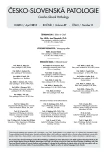Prague Hepatology Meeting 2010 – hepatopathology news
Authors:
J. Ehrmann
Authors‘ workplace:
Ústav patologie a Laboratoř molekulární patologie LF UP a FN Olomouc
Published in:
Čes.-slov. Patol., 47, 2011, No. 2, p. 50-51
Category:
Reviews Article
Overview
This review summarizes the highlights in hepatopathology presented during the Prague Hepatology Meeting 2010. Gut flora (microbiome) and intestinal permeability seems to play an important role during progression into liver cirrhosis in patients with non-alcoholic steatohepatitis. Molecular diagnosis allows the distinction of several types of hepatocellular adenoma with different risks of malignant progression. Experimental hepatology is currently focused on the role of epigenetics during pathogenesis of alcoholic liver disease. The most studied topic in viral hepatitis C is the mechanisms of resistance to antiviral treatment. Pathogenesis of liver fibrosis and the role of keratins in the pathology of liver disease are areas of scientific interest as well.
Keywords:
gut flora – liver cirrhosis – liver tumors – nonalcoholic steatohepatitis – regeneration of the liver – alcoholic liver disease – hepatitis C – fibrosis of the liver
Labels
Medical genetics Anatomical pathology Forensic medical examiner ToxicologyArticle was published in
Czecho-Slovak Pathology

2011 Issue 2
Most read in this issue
- Fibrosing cholestatic hepatitis – disease not only of transplanted patients. A report of eight cases
- Viral hepatitis at the beginning of the 21th century – value of liver biopsy in the context of development of new non-invasive diagnostic methods and in relation to the modern therapy of chronic viral hepatitis
- Pseudoangiomatous stromal hyperplasia with giant cells in the female breast. No association with neurofibromatosis?
- How to improve the histopathological diagnosis of hepatocellular carcinoma in daily practice?
